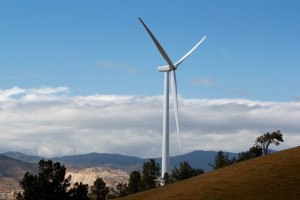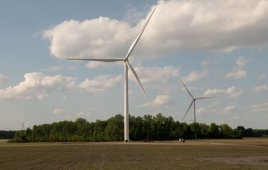 Condition monitoring is one way to keep tabs on all the equipment in a nacelle without a daily visit. SCADA systems provide some of this information, but a properly applied condition monitoring system provides more detail.
Condition monitoring is one way to keep tabs on all the equipment in a nacelle without a daily visit. SCADA systems provide some of this information, but a properly applied condition monitoring system provides more detail.
The idea is to mount sensors on bearings, gearboxes, and generators. Pressure sensors can tell that the hydraulic system is up and running, while temperature sensors report on general oil, bearing, and generator conditions. Accelerometers, however, may be most useful because they can track vibration in a bearing or gear train and, with special software called Fast Fourier Transform (FFT), provide useful information such as vibration frequency, which helps identify a particular bearing or gear. Then as a bearing wears, its frequency amplitude increases. This signal can be monitored from a location well away from the wind farm. The specifics of condition monitoring, however, are changing fast with many ideas for how it can be done.
Today’s accelerometers are extremely compact, which allows easily mounting them near rotating components such as bearings and gears. Typical installation is by glue on mounting bases that require no modifications to turbine components.
The process, according to one expert, breaks into four action points: identify accelerometer locations inside the turbine, determine a monitoring method appropriate for each location, analyze the data, and communicate the data collection.
Other condition-monitoring issues involve adapting traditional sensors to today’s larger distributed base of wind turbines. These have thousands of measurement points which diminish the cost effectiveness and adds additional system and organization complexity. By applying recent devices such as MEMS accelerometers and low-cost digital signal converters with ethernet communication, wind-farm operators can deploy condition-monitoring systems without a high level of vibration analysis knowledge, say some experts.
Effective blade-load sensing, a relatively new capability, allows rotor monitoring and load measuring on the turbine hub. Such a system can be designed-in during manufacturing or retrofitted. The system detects operation and maintenance issues such as blade icing, in which the system lets operators predict when they ought to shut down turbines because blade damage or “ice throw” is possible. Sensing when the ice has been shed from a blade also lets operators restart sooner. Such controls and sensors would allow for adjustments to:
• Yaw misalignments. When running below rated power, a 10° yaw misalignment reduces power output by about 5%.
• Rotor imbalance. Sensors that provide data on mass and aerodynamic imbalances allow early action to maximize power generation and avoid damage.
• Blade damage. Sensors can detect damage affecting the structural or aerodynamic performance of a blade, allowing early remedial action.
Also, sensors that count particles in oil may give a better idea when the oil needs cleaning or changing.
Filed Under: Uncategorized





What is the meaning of SCADA systems and how they are helpful foe us?